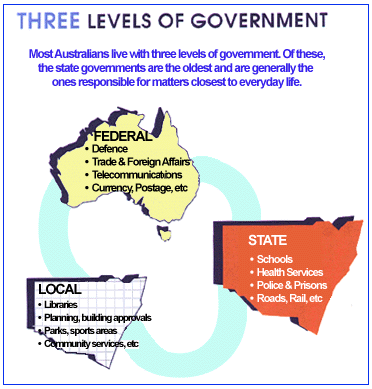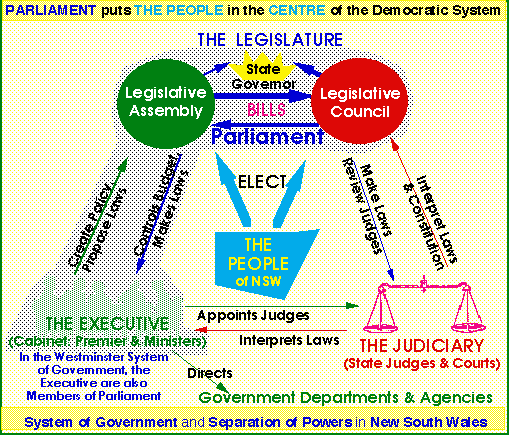A Democratic System
Australia is a democratic federal constitutional monarchy.
New South Wales is one of six sovereign states and two territories within the Federal Commonwealth of Australia. The six states existed before the Commonwealth but joined together in a Federation on 1 January 1901 to become a single nation. The Federal Constitution gave certain powers to the new Commonwealth of Australia but the states remained separate sovereign states, retaining responsibility for all other areas of activity not ceded to the Commonwealth.
At the time of Federation the states and Commonwealth were subject to the Queen of the United Kingdom. Today, Australia remains a constitutional monarchy, but over time - and especially since the Australia Acts of 1986 - it has become an entirely independent sovereign nation. Queen Elizabeth II is the Queen of Australia. Legally, this is an entirely separate role from her position as Queen of the United Kingdom. However, as the Queen is not resident in Australia, her role is carried out by her representatives in Australia: the Governor-General for the whole of Australia, and the State Governors for each of the six states. These representatives are appointed by the Queen on the advice of the different Australian governments and are fully independent of the Queen in carrying out their constitutional roles. They act on the advice of their elected governments.
The Australian Commonwealth and each of the states have their own written constitutions which, together with conventions, traditions and common and statute law, establish a democratic system of government.
Governments are formed as a result of democratic
elections for parliaments. All citizens, 18 years and over, vote and voting is compulsory in Australia. The result of the parliamentary elections decide who forms the government. Elections in New South Wales take place after a fixed term of four years.
Three Levels of Government

In the Australian federal system there are three levels of government: Federal, State, Local.
Each level of government is centred on a body (a parliament or a council) democratically elected by the people as their representatives. Each level of government has its own responsibilities, though many responsibilities are shared in various ways.
What is "the Government"?
When we talk of "government" we often mean all sorts of different things at once. Mostly, we mean the group that actually governs – that is, develops policy, makes decisions, controls the various government departments and agencies and carries these decisions out on a day to day basis. This is the executive, or, in Australia, the Cabinet or Ministry.
In the Westminster style of government adopted in Australia, the majority party in the lower house of the Parliament (in New South Wales this is the Legislative Assembly) forms "the government". The members of that party sit in the Chamber to the right of the Speaker and are referred to in parliament as "the government". However, Parliament’s role is not so much to govern as to legislate and to scrutinise government. Leading members of the majority party become the Ministers, the chief minister in the states being called "the Premier". This group (the Ministry or Cabinet or Executive) are in charge of government departments and agencies. They collectively and individually determine government policy and are responsible for its being carried out by government agencies. They govern, so they really are "the government".
However, in the Westminster system, the Ministers also remain members of parliament and, as ministers, are responsible to it (and through parliament, to the people) for their actions. Because of this responsibility of each Minister to Parliament for their actions, we speak of this as Responsible Government.
The Structure of Government in New South Wales

There are three main branches or elements of government: legislative, executive and judiciary:
- The Legislature makes the laws. The Legislature consists of the Parliament of New South Wales, made up of two Houses (the Upper House or Legislative Council, and the Lower House or Legislative Assembly) together with the Governor of NSW.
- The Executive administers or applies the laws. The Executive is made up of the Premier and Cabinet or Ministers (currently 19 but there can be up to 21). Each minister is responsible for one or more government departments or agencies. They are appointed from amongst the majority party in Parliament and remain members of Parliament.
- The Judiciary adjudicates on the laws. The Judiciary is made up of independent judges appointed to a hierarchical system of courts, the highest being the NSW Supreme Court. There are also a series of federal courts with jurisdiction in New South Wales. Above them all, the Commonwealth High Court has been established as the highest court for the whole of Australia.
Each of these branches of government therefore has separate functions and is, to some extent at least, separate from each other. But each one is also linked with the other two, having some powers over the others, just as the other branches have some power over it. No one branch controls all the power in a democratic system. We refer to this as The Doctrine of the Separation of Powers.
